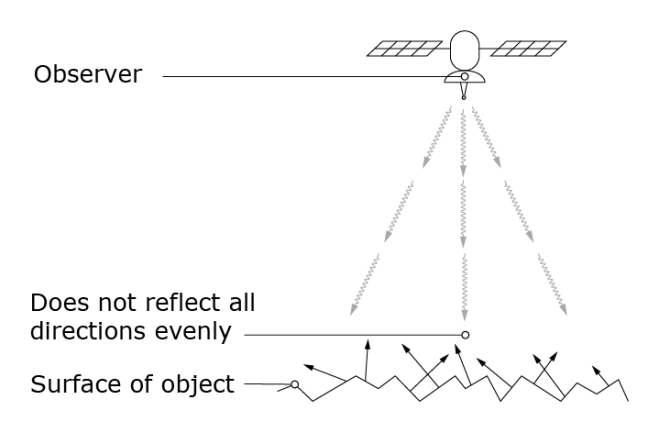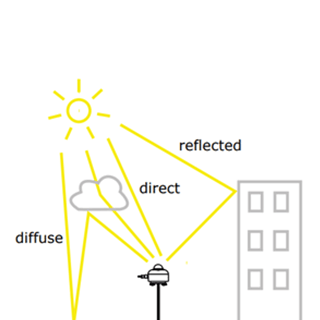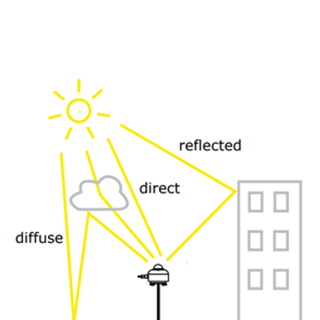Solar radiation measurement
In this article we will provide information about solar radiation measurement. What is solar radiation measurement and how can you actually measure solar radiation?
The sun is the driving force behind large weather patterns and other natural phenomena. The energy of the sun is what makes life as we know it possible. This solar energy is transmitted by a form of heat flux called radiation. Radiation often refers to the amount of energy that is emitted by the emitter, in this case the sun. Irradiance, a very similar term, refers to the amount of radiative energy received by a body, in this case the earth.
What is radiation?
Radiation is one of the three types of heat flux. The other two types are explained here: What is heat flux? It is a way of transferring thermal energy and is expressed in watts per square meter (W/m2). Every object emits radiative energy. The higher the temperature of the object, the more radiation it emits. Radiation is thermal energy in the form of electromagnetic waves. These electromagnetic waves can have particular wavelengths and frequencies that dictate the properties of the radiation. Many modern devices use electromagnetic waves for communicating information like televisions, radio signals or cellphones.
Solar radiation is a mix of various types of radiation. In the image below, different types of radiation are depicted with their corresponding wavelengths.
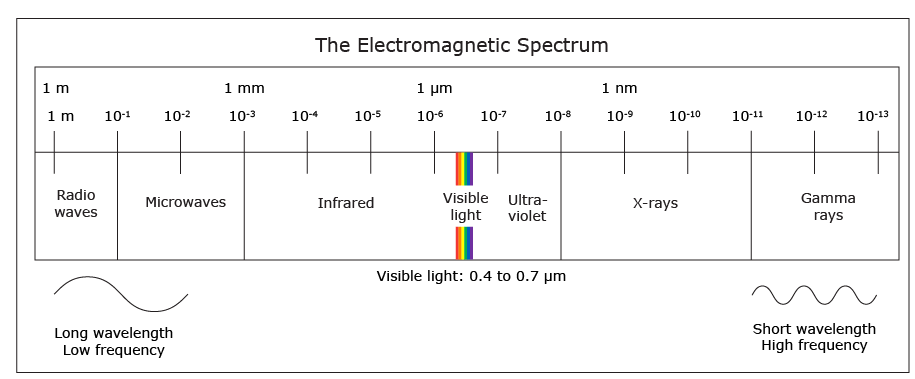
Radiators emit all wavelengths and thus all types of radiation at least to some degree. The temperature of the emitter dictates what wavelengths are emitted mostly. In essence, the hotter the object emitting the radiation, the shorter the wavelengths of the emitted radiation.
The sun emits types of radiation according to the following distribution, (Climate bits solar radiation, 2015):
- 49% consists of infrared wavelengths
- 43% consists of the visible wavelengths
- 7% consists of ultra violet wavelengths
- < 1% consists of radio waves, microwaves, x rays and gamma rays
As the visible part of the electromagnetic spectrum is considered short wavelengths, we can conclude that roughly half of the emitted radiation is shortwave radiation and half is longwave radiation.
Radiation between two bodies
When talking about radiation, a ‘body’ refers to an object either emitting or receiving radiation. The amount of radiation that is transferred from one body to a second body, heavily depends on the temperatures of both bodies.
The expression for the thermal energy exchange is as follows, (Mills, 1999):
With: ![]() = radiative heat flux from body 1 to 2. [W]
= radiative heat flux from body 1 to 2. [W] ![]() = The transfer factor from body 1 to 2. [-]
= The transfer factor from body 1 to 2. [-] ![]() = The radiative surface of body 1. [m2]
= The radiative surface of body 1. [m2] ![]() = Stefan-Boltzmann constant of 5.67 * 10-8. [W/m2K4]
= Stefan-Boltzmann constant of 5.67 * 10-8. [W/m2K4]
T1 = Temperature of body 1 at the surface. [K]
T2 = Temperature of body 2 at the surface. [K]
The transfer factor depends on the relation of the sizes and shapes of both body 1 and body 2. It is also dependent on the emissivity of body 1, the emitter. The transfer factor is different for every situation and can range between 0 and 1. The Stefan-Boltzmann constant is independent of the situation and always has the same value.
Note that the temperatures of the bodies are raised to the fourth power, indicating a very exponential process. At higher absolute values, the same temperature difference results in a higher exchange of radiative heat.
Why measure solar irradiance?
The radiation of the sun is not only the driving force of natural phenomena, but also of photovoltaic systems, otherwise known as solar power systems. These systems make use of solar irradiance by converting the radiative energy into an electric current with solar panels. The power output of such a system is considered sustainable, green, solar power.
To see if an area is a good candidate for a PV system, it is crucial to know the quantity of radiation that is received and emitted by the surface of that particular place. Knowing the quantities of different types of irradiance at different seasons, times, angles and weather conditions is very useful for developing a good strategy for maintaining a PV system. Of course, the same is true for ecological reasons when a study requires the energy balance of a certain area.
Different types of solar radiation measurements
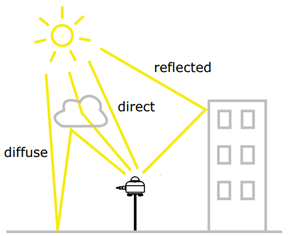
Not all radiation reaching the earth makes it to the ground. Radiation can be reflected, absorbed and again emitted, for instance, by clouds and buildings. The following image depicts a schematic of radiation reaching a measurement system.
There are a lot of different values that could be required to measure solar radiation. Different combinations of various solar radiation sensors or radiation measurement devices can create a system capable of calculating all different types of solar irradiance.
One of the distinctions to be made is the path in which radiation finds a surface:
GHI = DNI + DHI
With:
GHI = Global Horizontal Irradiance
DNI = Direct Normal Irradiance
DHI = Diffuse Horizontal Irradiance
The global horizontal irradiance (GHI) is the total of radiation that finds the top of a measuring system. The Direct Normal Irradiance (DNI) is the radiation that finds the sensor directly from the sun. The Diffuse Horizontal Irradiance (DHI) is the radiation that is reflected and emitted by surrounding bodies.
Secondly, a distinction can be made between longwave radiation and shortwave radiation. The longwave radiation and the shortwave radiation make up the total radiation. A pyrgeometer is capable of measuring only longwave radiation by making use of a silicon dome that functions as a filter for the shortwave radiation.
The following table presents the wanted solar irradiance values and the needed combination of devices:
| Irradiance Type | Name | Combination | Range |
| Direct Normal Irradiance | Pyrheliometer | (-) | 200 – 4.000 nm |
| Global Horizontal Irradiance | Pyranometer | (-) | 285 – 3.000 nm |
| Diffuse Horizontal Irradiance | Shaded Pyranometer | Pyranometer and a shading eye, preventing the DNI to reach the sensor | 285 – 3.000 nm |
| Longwave irradiance | Pyrgeometer | (-) | 1.000 – 50.000 nm |
| Shortwave irradiance | Pyrgeometer and pyranometer | 285 – 400 nm | |
| Albedo | Albedometer | 2x pyranometer | 285 – 3.000 nm |
| Net radiation | Net radiometer | 2x pyranometer, 2x pyrgeometer | 285 – 3.000 nm (solar) 4.500 – 42.000 nm (longwave) |
The albedo is a value describing the reflectance of a surface. The more radiation a surface reflects, the higher the albedo of that surface. If you want to learn more about albedo and how it is measured, please read the article: What is albedo?
How to install a radiation measurement device
According to the type of solar irradiance that you want to measure, the correct radiation measurement device should be chosen. The installment of this particular device is very important for generating accurate solar radiation measurements. Especially the location of installment of the radiation measurement device plays a crucial role.

Pyranometers have a hemispherical lens, measuring every part of the sky. Ideally, you want to prevent any obstacles blocking the sun directly above it. Obstructions in the field of view are dismissible as long as they don’t exceed an elevation of 5 degrees in relation to the pyranometer. Flat, reflective surfaces near the lens should be avoided altogether. Rooftops are commonly used installment sites.
Pyrheliometers are commonly used to measure the direct sunlight, thus need to track the position of the sun during the day. Pyrheliometers have standardized 38 mm diameter tubes so they can easily be mounted on a solar tracker. A solar tracker is an installation that follows the place of the sun in the sky for a particular time and place.
After installment of the solar radiation measurement device
After installing the solar radiation measurement device, it is important to keep track of your data. Checking whether the data aligns with clear-sky models is a good way to start to see if the system does not put out unrealistic data. Calibration is also part of maintaining the measurement system and ensuring accuracy and reliability. For more tips on measuring solar irradiance efficiently, please read the article: Solar radiation measurement.








